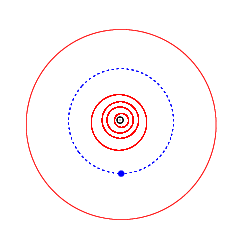9910 Vogelweide
|
| |||||||||||||
| Discovery | |||||||||||||
|---|---|---|---|---|---|---|---|---|---|---|---|---|---|
| Discovered by | C. J. van Houten, I. van Houten-Groeneveld & T. Gehrels | ||||||||||||
| Discovery date | 30 September 1973 | ||||||||||||
| Designations | |||||||||||||
| MPC designation | 9910 Vogelweide | ||||||||||||
Named after | Walther von der Vogelweide | ||||||||||||
| 3181 T-2, 2115 T-1 | |||||||||||||
| Orbital characteristics[1] | |||||||||||||
| Epoch 13 January 2016 (JD 2457400.5) | |||||||||||||
| Uncertainty parameter 0 | |||||||||||||
| Observation arc | 16210 days (44.38 yr) | ||||||||||||
| Aphelion | 2.9669330 AU (443.84686 Gm) | ||||||||||||
| Perihelion | 2.7743838 AU (415.04191 Gm) | ||||||||||||
| 2.8706584 AU (429.44438 Gm) | |||||||||||||
| Eccentricity | 0.0335375 | ||||||||||||
| 4.86 yr (1776.5 d) | |||||||||||||
| 211.80874° | |||||||||||||
| 0° 12m 9.515s / day | |||||||||||||
| Inclination | 3.367449° | ||||||||||||
| 95.19398° | |||||||||||||
| 305.18784° | |||||||||||||
| Earth MOID | 1.78225 AU (266.621 Gm) | ||||||||||||
| Jupiter MOID | 2.17181 AU (324.898 Gm) | ||||||||||||
| Jupiter Tisserand parameter | 3.295 | ||||||||||||
| Physical characteristics | |||||||||||||
| Dimensions | ~23.4 km[2] | ||||||||||||
| 118.9048 h (4.95437 d) | |||||||||||||
| ~0.01 | |||||||||||||
| |||||||||||||
| 13.7 | |||||||||||||
|
| |||||||||||||
9910 Vogelweide is a main belt asteroid. It orbits the Sun once every 4.87 years.[1]
Discovered on September 30, 1973 by Cornelis Johannes van Houten and Ingrid van Houten-Groeneveld on photographic plates made by Tom Gehrels with the Samuel Oschin telescope at the Palomar Observatory, it was given the provisional designation "3181 T-2". It was later renamed "Vogelweide" after Walther von der Vogelweide, a German minstrel of the thirteenth century.[3]
References
- 1 2 "9910 Vogelweide (3181 T-2)". JPL Small-Body Database. NASA/Jet Propulsion Laboratory. Retrieved 13 April 2016.
- ↑ Tedesco E.F.; Noah P.V.; Noah M.; Price S.D. "The supplemental IRAS minor planet survey (SIMPS)".
- ↑ MPC 34356 Minor Planet Center
External links
This article is issued from Wikipedia - version of the 9/10/2016. The text is available under the Creative Commons Attribution/Share Alike but additional terms may apply for the media files.
